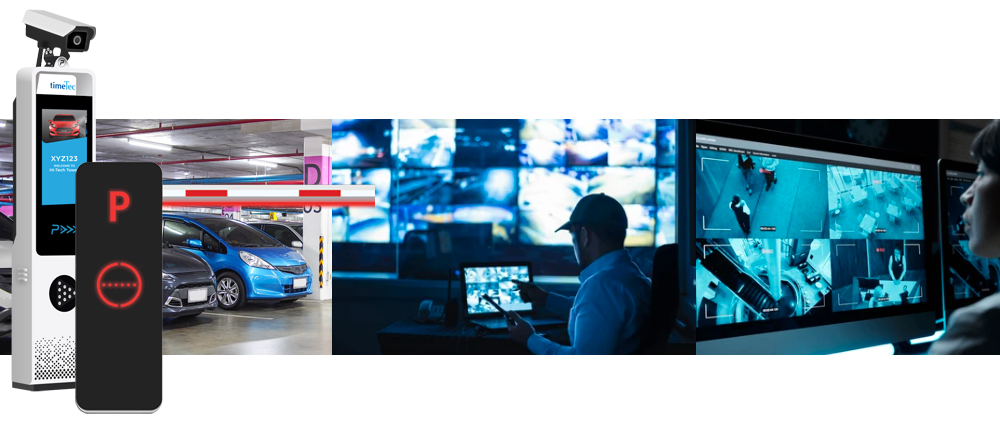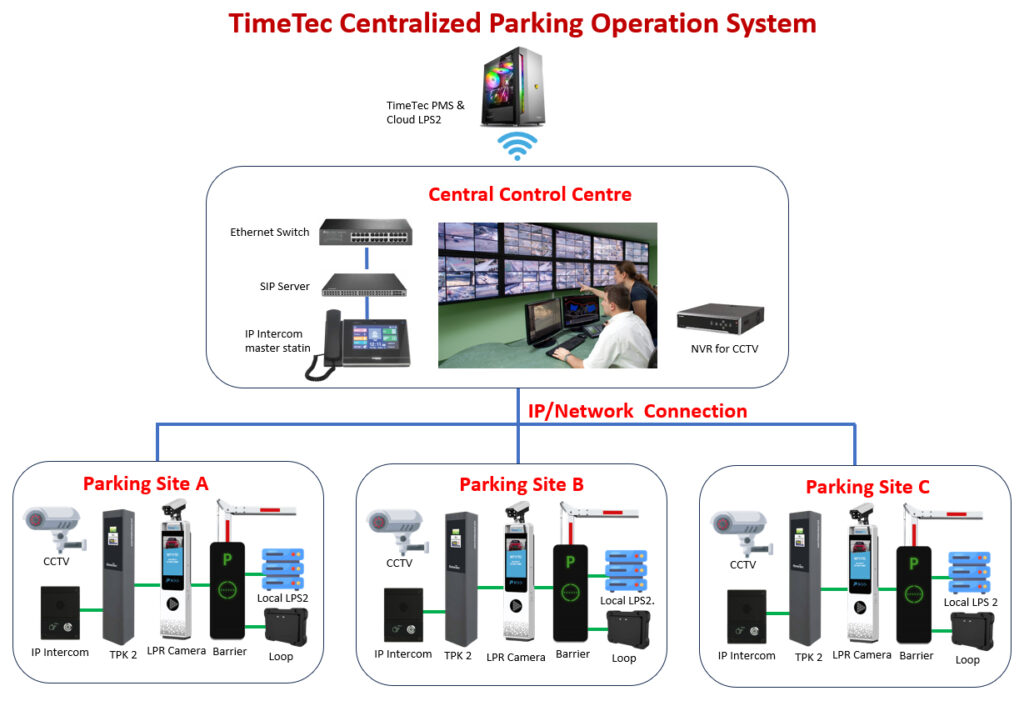
The increase in the minimum wage from RM1,500 to RM1,700, which took effect on 1st February 2025 in Malaysia, has significantly impacted many industries. Parking operators may struggle to request higher management fees from site owners due to existing contracts that have yet to be renewed. In the long run, parking operations should focus on improving efficiency and reducing overall operating costs.
For operators managing multiple sites, technology offers a way to centralize parking operations. This centralization can help lower headcount and reduce staffing expenses, contributing to better cost management in an increasingly competitive environment.
Below we outline the key areas and action levels (mixture of technologies and operation requirements) of centralized parking operation across multiple parking sites.
D. Centralized Terminal Control
E. Centralized Emergency Handling
Each level focuses on different aspects of ensuring a cohesive and efficient parking operation from a central command.

A. Centralized Monitoring
1. Real-Time Occupancy & Status Tracking
- Ensure all parking sites report real-time occupancy data (e.g., number of available spots).
- Either by site, individual bay by Integrating sensors or counters (e.g., cameras, loop detectors, or other IoT sensors) with a central dashboard.
2. Video Surveillance Integration
- Centralize CCTV footage from all sites for 24/7 monitoring.
- Set up standardized camera configurations and recording protocols.
- Establish retention policies for recorded video.
3. License Plate Recognition (LPR)/ANPR & Access Data
- Integrate LPR/ANPR systems into the centralized monitoring platform.
- Monitor vehicle entries/exits in real-time.
- Maintain proper data privacy and retention regulations.
4. Alarm & Alert Systems
- Configure real-time alerts for critical system failures (e.g., gate malfunctions, payment kiosk errors).
- Implement automated notifications (SMS, email, push notifications, mobile app) to relevant personnel.
5. Data Analytics & Reporting
- Generate regular reports on occupancy trends, peak usage times, and revenue.
- Use centralized operation dashboards to identify patterns or anomalies.
- Integrate analytics tools for forecasting and predictive maintenance.
6. Performance Metrics & KPIs
- Track site-by-site KPIs such as turnover rate, average dwell time, revenue per space, etc.
- Compare performance across all sites to identify best practices or potential improvements.
B. Centralized System Setup
1. Standardized Hardware & Software
- Adopt uniform gate controllers, payment kiosks, sensor systems, and CCTV hardware.
- Implement a unified software platform or cloud-based service to manage all sites.
2. Integration with Third-Party Services
- Connect payment gateways (e.g., credit card processors, mobile payment apps).
- Integrate with local transit or city mobility platforms for seamless user experiences.
- Ensure API compatibility and secure data exchange protocols.
3. Data Architecture & Security
- Define data flow architecture (from on-site devices to central servers/cloud).
- Implement encryption and secure channels (VPN, SSL/TLS) for all data transfers.
- Adhere to relevant data protection regulations (e.g., GDPR, CCPA if applicable).
4. Scalability & Redundancy
- Design the system to add new sites without significant downtime or reconfiguration.
- Set up redundant servers or cloud instances for failover and high availability.
- Conduct routine tests for disaster recovery and backup processes.
5. Implementation & Onboarding
- Create a phased plan for migrating each site to the centralized system.
- Provide training to on-site staff regarding new procedures and tools.
- Document system architecture, configuration guides, and user manuals.
C. Centralized Management
1. Operational Policies & Procedures
- Standardize policies for parking rates, validations, enforcement, and fines.
- Ensure consistent operating procedures (SOPs) across all sites.
2. Pricing & Revenue Control
- Centrally manage dynamic pricing or promotions based on occupancy or demand.
- Monitor revenue streams in real-time for each site.
3. Staffing & Personnel Coordination
- Standardize job roles, responsibilities, and training curricula for on-site personnel.
- Centralize scheduling, shift management, and performance reviews.
4. Maintenance & Vendor Management
- Implement a unified maintenance schedule for equipment checks and repairs.
- Coordinate with vendors (hardware, software, security) through a central helpdesk or ticketing system.
- Track maintenance logs and service-level agreements (SLAs).
5. Customer Support & Service
- Set up a single point of contact (call center or online chat) for all parking inquiries.
- Standardize escalation procedures for refunds, complaints, or disputes.
6. Audit & Compliance
- Conduct regular compliance checks with local regulations (safety, accessibility, etc.).
- Use central logs to audit financial transactions, equipment status, and user activities.
D. Centralized Terminal Control
1. Remote Gate & Barrier Control
- Enable remote operation (open/close) of gates and barriers from the central control center.
- Integrate gate status (open/closed/fault) with the central monitoring dashboard.
2. Kiosk & Payment Terminal Management
- Implement remote software updates and patches for payment kiosks.
- Monitor terminal status (online/offline, paper levels, card reader health) centrally.
- Standardize troubleshooting procedures for common terminal issues.
3. Automated Diagnostics & Self-Healing
- Configure automated checks for hardware malfunctions or connectivity issues.
- Trigger self-diagnostic tools or direct on-site staff when alerts appear.
4. Centralized Configuration Management
- Maintain a central configuration repository for all device settings (pricing, language, display).
- Enforce consistency across all terminals (e.g., the same user interface at every site).
5. Alarm & Escalation
- Define clear escalation paths for terminal failures (who to contact, time-to-response).
- Link alarms to the centralized helpdesk for quick assignment to technical teams.
E. Centralized Emergency Handling
1. Emergency Response Plan
- Define clear roles and responsibilities for central and on-site teams.
- Create standardized protocols for handling urgent events (e.g., power outages, technical system failures, security incidents).
2. Crisis Communication
- Maintain up-to-date contact information for all site managers and emergency services.
- Establish procedures for communicating with customers during emergencies (e.g., signage, public announcements, push notifications).
3. Contingency Procedures
- Identify backup power solutions (generators, UPS) and test them regularly.
- Develop fallback processes for manual operations if IT systems go down (e.g., ticket validation, manual gate operation).
4. Evacuation & Access Control
- Ensure compliance with local fire and safety regulations.
- Standardize evacuation routes and muster points for each location.
- Implement quick lock/unlock mechanisms for gates or barriers if needed.
5. Post-Incident Review & Documentation
- Conduct after-action reviews to capture lessons learned.
- Update emergency plans and SOPs based on real incidents or drills.
- Compile documentation on incident timelines, resolutions, and improvements.

Final Tips for Implementation
- Pilot and Scale: Start with a pilot site to validate processes and technology before rolling out to all parking facilities.
- Continuous Improvement: Use metrics, feedback, and audits to refine centralized processes and systems regularly.
- Training & Change Management: Ongoing staff training and clear communication are critical to ensuring adoption of centralized protocols.
- User Experience Focus: Keep the end customer in mind—prioritize simplicity, speed, and reliability for parking operations.
The five centralized levels outlined above can serve as a practical checklist, providing a structured overview of the tasks and considerations involved in implementing and managing a centralized parking operation for multiple sites. You can adapt these guidelines to meet your organization’s specific needs, legal obligations, and technological constraints, ensuring a smooth rollout and long-term sustainability.
If you’re looking to streamline your parking operations across multiple sites, consider TimeTec Parking—an all-in-one smart parking solution that can help simplify processes and reduce costs.
